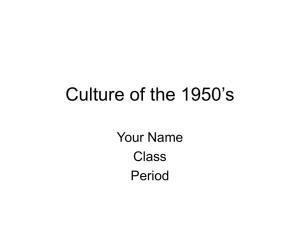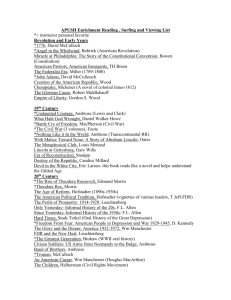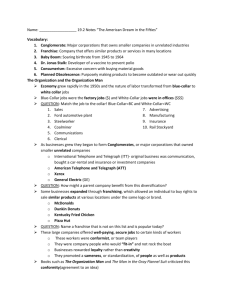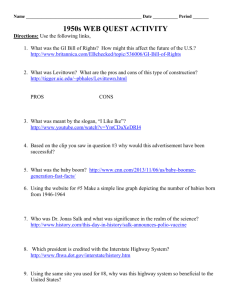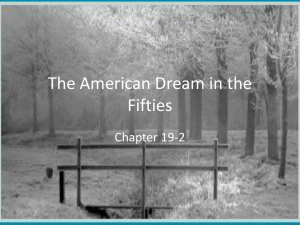1950s
advertisement
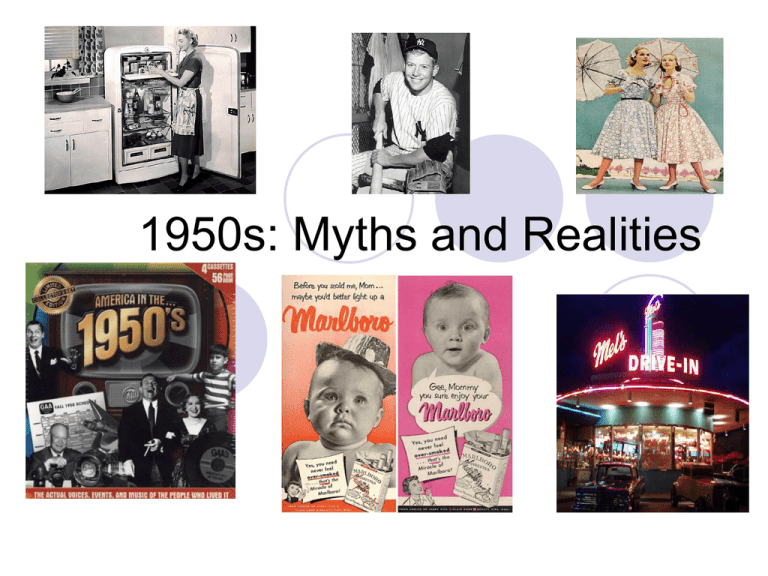
1950s: Myths and Realities I. Consensus and Contentment A. Myths: 1. economic expansion improved life for all Americans 2. consumerism and technological advancements made life better for all Americans 3. suburbanization made life better for all Americans 4. Consensus, or a general agreement about values, likes, and dislikes, reflected a more happy, unified America B. Realities: 1. economic expansion did not improve life for all Americans a. overall, the economy did improve and programs like the GI Bill, which allowed veterans to go to college and buy a home, expanded the middle class. b. poverty rate in 1950s was over 20% in some areas and wages for the working class remained low c. white flight, or movement of middle-class Americans to the suburbs, left inner cities with poor schools, public transportation, and police/fire departments 2. consumerism and technological advancements were a mixed blessing a. facing higher prices and lower wages, many workers went on strike b. technology led to layoffs in some industries c. credit cards and installments led to private debt growing from $73 billion to $179 billion B. Realities, cont. 3. suburbanization did not make life better for all Americans a. suburban sprawl and the creation of the interstate highway system led to bad traffic and the destruction of nature b. many suburbs discriminated against minorities (i.e. “track housing” like Levittown required people to sign contracts agreeing not to sell to African Americans). c. urban renewal projects, which included tearing down old housing and constructing new low-income housing, could not accommodate for all the poor. “Project” housing led to increased crime in some areas. Levittown, PA "As a Jew, I have no room in my mind or heart for racial prejudice," Levitt insisted in 1954. "But, by various means, I have come to know that if we sell one house to a Negro family, then 90 to 95 percent of our white customers will not buy into the community. That is their attitude, not ours." B. Realities, cont. 4. there was no real consensus in the 1950s, and the country was divided through racism and segregation a. the South still had segregated facilities b. changes such as school desegregation in the South caused an increasing divide over race issues c. racial violence continued in the North and South d. In the West, Mexican immigrants that came over through the bracero program in WWII faced segregation and discrimination. e. The termination policy, which eliminated federal support to Indian reservations, left many Native Americans without jobs and medical care (the government abandoned this policy in 1963) The Longoria Incident Army Pvt. Felix Longoria, a native of the small South Texas town of Three Rivers whose remains were returned from the Philippines for burial four years after World War II started when Mr. Longoria’s widow, Beatriz, had been denied use of a hometown funeral chapel because the Longorias were MexicanAmerican. She was told that the "white people would not stand for it." The funeral home had indicated that it would handle the arrangements for burial (in the segregated "Mexican" cemetery separated by a barbed wire), but would not allow the use of the chapel for the wake. II. Women and Domesticity A. Myths: 1. all women were happy to return to the domestic sphere and focus on child rearing after WWII B. Realities: 1. most women did return to the home after WWII A. Baby Boom: late 1940s through early 1960s; led to the largest generation in the nation’s history 2. many women continued to work or obtain a higher education after WWII a. over 25% of women worked outside the home in the 1950s b. many working class women could not afford to stay home 2. not all women were satisfied with homemaking a. Betty Friedan’s Feminine Mystique discussed “the problem that has no name” b. some women complained about boredom and unhappiness III. Youth Rebellion A. Myths: 1. the youth of the 1950s were the more rebellious and dangerous than ever before 2. Beatniks, artists that expressed social and political non-conformity, were dangerous subversives B. Realities: 1. Youth were not more rebellious and dangerous a. Crime rates and youth offenses went down in the 1950s b. fear of youth stemmed from music, movies, and pop culture 2. Beatniks merely illustrated the darker side of the decade a. fear of the atom bomb b. fear generated by McCarthyism and the Red Scare

